Arastoo Badoei dalfard by Arastoo Badoei-Dalfard
Papers by Arastoo Badoei-Dalfard
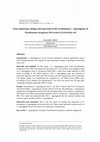
Introduction: Lasparaginase is in an excessive demand in medical applications and in food treatin... more Introduction: Lasparaginase is in an excessive demand in medical applications and in food treating industries, the request for this therapeutic enzyme is growing several folds every year. Materials and methods: In this study, a Lasparaginase gene from Pseudomonas aeruginosa strain SN4 was sequenced and cloned in E. coli. Primers were designed based on Lasparaginase from P. aeruginosa DSM 50071, which show high similarity to SN4 strain, according to 16S rRNA sequence. The Lasparaginase gene was exposed to restriction digestion with NdeI and XhoI enzymes and then ligated into pET21a plasmid. The ligated sample was transformed into competent E. coli (DE3) pLysS DH5a cells, according to CaCl2 method. The transformed E. coli cells were grown into LB agar plate containing 100 μg/ml ampicillin, IPTG (1 mM). Results: Recombinant Lasparaginase from E. coli BL21 induced after 9 h of incubation and showed high Lasparaginase activity about 93.4 IU/ml. Recombinant Lasparaginase sequencing and al...

Journal of the Iranian Chemical Society, 2021
Recently, biodiesel production has received extensive attention as an alternative energy source t... more Recently, biodiesel production has received extensive attention as an alternative energy source to conventional fuel. It is non-polluting fuel and combines environmental friendliness with low toxicity, renewability, and biodegradability. Immobilized lipases have been found emerging catalysts for the synthesis of biodiesel. In the current study, we used lipase Km12 to construct three efficient immobilized enzymes, including lipase@ZIF-8 (LZIF), silica@Lipase@ZIF-8 (SLZIF), and silica@Lipase@ZIF-8/graphene oxide (GSLZIF). The results exhibited that the apparent K m and k cat amounts for these immobilized enzymes were higher than that of the free lipase. The GSLZIF exhibited the maximum lipase activity in the pH 8.0–10, in which the free lipase showed the maximum activity in pH 8.0. GSLZIF showed 4.3-fold more activity than the free lipase after 60 min of incubation at 40 °C. This immobilized lipase showed a 17% enhancement in the lipase activity in the presence of 50% of methanol compared to the free lipase. Results showed that the GSLZIF retained 77% of initial protein loading after 10 cycles of reusing. Furthermore, GSLZIF showed 88% biodiesel yield from Terminalia chebula oil after 18-h incubation, whereas the free lipase showed 38% biodiesel yield at the same conditions. Taken together, remarkable improvement of biodiesel production (2.3-fold), higher thermal stability (4.9-fold) and higher k cat (3.5-fold) of GSLZIF compared with free lipase are the main results of this research. These results indicated that the GSLZIF has high potential in industrial applications, especially in biodiesel production.
Recently, biodiesel production has received extensive attention as an alternative energy source t... more Recently, biodiesel production has received extensive attention as an alternative energy source to conventional fuel. It is non-polluting fuel and combines environmental friendliness with low toxicity, renewability, and biodegradability. Immobilized lipases have been found emerging catalysts for the synthesis of biodiesel. In the current study, we used lipase Km12 to construct three efficient immobilized enzymes, including lipase@ZIF-8 (LZIF),
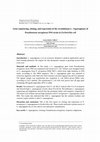
Introduction: L- asparaginase is in an excessive demand in medical applications and in food treat... more Introduction: L- asparaginase is in an excessive demand in medical applications and in food treating industries, the request for this therapeutic enzyme is growing several folds every year.
Materials and methods: In this study, a L- asparaginase gene from Pseudomonas aeruginosa strain SN4 was sequenced and cloned in E. coli. Primers were designed based on L- asparaginase from P. aeruginosa DSM 50071, which show high similarity to SN4 strain, according to 16S rRNA sequence. The L- asparaginase gene was exposed to restriction digestion with NdeI and XhoI enzymes and then ligated into pET21a plasmid. The ligated sample was transformed into competent E. coli (DE3) pLysS DH5a cells, according to CaCl2 method. The transformed E. coli cells were grown into LB agar plate containing 100 µg/ml ampicillin, IPTG (1 mM).
Results: Recombinant L- asparaginase from E. coli BL21 induced after 9 h of incubation and showed high L- asparaginase activity about 93.4 IU/ml. Recombinant L- asparaginase sequencing and alignments showed that the presumed amino acid sequence composed of 350 amino acid residues showed high similarity with P. aeruginosa L- asparaginases about 99%. The results also indicated that SN4 L- asparaginase has the catalytic residues and conserve region similar to other L- asparaginases.
Discussion and conclusion: This is the first report on cloning and expression of P. aeruginosa L- asparaginases in Escherichia coli. These results indicated a potent source of L- asparaginase for in vitro and in vivio anticancer consideration.
Key words: L- asparaginase, Cloning, Pseudomonas aeruginosa, Sequence alignments
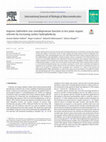
Organic solvents tend to strip water from protein and thereby disrupt non-covalent forces and dec... more Organic solvents tend to strip water from protein and thereby disrupt non-covalent forces and decrease enzyme activity and stability. In the present study, we have replaced the surface charge residues in Salinivibrio zincmetalloprotease (SVP) with hydrophobic ones (E12V, D22I, D24A and D310I) in order to study the effects of surface hydrophobicity with hydrophobic strength of organic solvents. Compared to SVP, D24A exhibited an increase in k cat and catalytic efficiency and a reduction in thermal inactivation rate in aqueous solvent. Structural studies indicated that the replacement of surface charge residues with hydrophobic residues would not induce conformational changes. C 50 value (the value of solvent concentration where 50% of enzyme activity remains), k i (irreversible thermoinactivation rate), and kinetic parameters of E12V, D22I, and D24A were higher in isopropanol and n-propanol. D24A is found to be the most efficient mutant for its remarkable decrease in k i value in the presence of isopropanol and n-propanol and a reduction in k i value in the presence of dimethylformamide (DMF) and methanol. C 50 value in this variant was increased about 1.2% in DMF, 2% in methanol and isopropanol and 2.5% in n-propanol. Results revealed that, there was a correlation between surface hydrophobicity of SVP and hydrophobic strength of organic solvents.
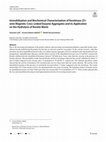
Due to the increasing development of the poultry industry and increasing environmental pollution,... more Due to the increasing development of the poultry industry and increasing environmental pollution, especially keratin waste, efficient keratin hydrolyzing biocatalyst has become an attractive goal for researchers. In the current research, a Bacillus keratinase has been immobilized based on the cross-linked enzyme aggregates (CLEAs) method on the functionalized Fe 3 O 4 nanoparticles. Immobilization efficiency and the relative activity of the immobilized enzyme were 87 and 84%, respectively. Results exhibited that the immobilized keratinase showed 7.96 folds more Vmax value than free enzyme in the presence of keratin substrate. Thermostability results showed that the mCLEAs-keratinase improved the enzyme stabilities by about 3.5 and 5.8 folds compared to free enzyme after 3 h incubation at 70 and 80 °C, respectively. The substrate specificity results showed that the activity of keratinase 2S1 toward keratin was five times more than the casein substrate. The activity of the immobilized enzyme in the presence of acetonitrile increased about 7.3 times compared to the free keratinase. The results showed that 43% of the enzyme activity was maintained after ten cycles of reusing. The hydrolysis degree of keratin wastes by immobilized enzyme was three folds more than free enzyme after 2 h of incubation at 42 °C. These results indicated that the free and immobilized keratinases had high potential activities for recycling keratin waste.
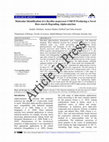
Microbial alpha-amylases demonstrate more compatibility with industrial demands. These industrial... more Microbial alpha-amylases demonstrate more compatibility with industrial demands. These industrial enzymes have potential applications in various industrial parts, e.g., starch processing, brewing, baking bread, pharmaceuticals, and detergents. In this study, a mesophyll bacterium, Bacillus mojavensis strain UMF29, has been identified based on the 16S rDNA sequence and phylogenetic tree. After 72 h of incubation at 37 °C, the plates were inoculated with Lugol's iodine, and the alpha-amylase-producing isolates were distinguished by clear zones in the blue background of starch agar plate around the colonies. Biochemical characterization of this enzyme was also investigated. Results showed that the optimal activity of this enzyme was at 50 °C, and pH of 7.0. In addition, the alpha-amylase exhibited optimum stability at 40 °C, and pH of 7.0. Some metal ions including Mn 2+ , Cu 2+ , Ca 2+ , Fe 2+ , Zn 2+ , Hg 2+ , and Mg 2+ stimulated the alpha-amylase activity by about 122, 105, 61, 47, 46, 23 and 16%, respectively. The best activity of this enzyme was achieved in 0.5 M of KCl (81% enhancement), and 1.5 M of NaCl (9% enhancement). This alpha-amylase hydrolyzed a wide range of raw-starch granules (1.0 %, w/v) including potato, corn, grain, rice, and wheat and optimally was effective on wheat starch (16%, w/v) at 45 °C for 6 h with relative hydrolyses of ~10 U/ml. To our knowledge, it was also found that the alpha-amylase was a Ca 2+-dependent enzyme for hydrolyzing higher concentrations of raw wheat starch (90-180 mg/ml) after 6 h of incubation at 45 ℃. Finally, these results indicated that UMF29 alpha-amylase showed high capacity in the degradation of the raw starch.

Bacterial fibrinolytic proteases achieved more attention in the prevention and treatment of cardi... more Bacterial fibrinolytic proteases achieved more attention in the prevention and treatment of cardiovascular diseases, so purification, characterization, and activity enhancement are of prime importance. In this study, a fibrinolytic serine metalloprotease was purified from the culture supernatant from Bacillus sp. BC1. It was purified to homogeneity by a two-step procedure with a 24-fold increase in specific activity and a 33.1% yield. It showed 28 kDa molecular weight, while its optimal pH and temperature were obtained 8 and 50-60°C. The cross-link enzyme aggregates of this fibrinolytic BC1 successfully immobilized on magnetic chitosan nanoparticles. A 52% activity enhancement was obtained by immobilized enzyme at pH 6.0, compared to free protease. K m values of the free and immobilized proteases were obtained about 0.638 and 0.61 mg/ml, respectively. The free and immobilized enzymes did not show any activity concerning transferrin, γ-globulins, and hemoglobin, as blood plasma proteins. The in vitro blood clot lysis test of the free and immobilized proteases showed a maximum of 42 and 50% clot lysis, which was comparatively higher than that revealed by streptokinase and heparin at the same condition. These results indicated that the free and immobilized proteases have the potential to be effective fibrinolytic agents.
Preparative Biochemistry and Biotechnology, May 20, 2014

Recently, enzyme immobilization via self-assembly of magnetic metal-organic frameworks (mMOFs) ha... more Recently, enzyme immobilization via self-assembly of magnetic metal-organic frameworks (mMOFs) has attracted attention for researchers. In this study, a Bacillus protease KHB3 was embedded into a magnetic metal organic framework. Temperature activity results shown that the free protease displayed the optimal activity at 40 °C, while the immobilized protease showed the highest activity at 60 °C. Besides, a 20% improvement in the activity of the immobilized form was found at 80 °C against the free protease. Furthermore, the Vmax of immobilized enzyme was 1.75 fold more than the free enzyme. Results exhibited that the immobilized protease showed 1.54 and 1.55 folds more activity than the control toward fibrin and gelatin, respectively. The immobilized protease reserved about twofold higher activity than the free protease after 21 days of storage. Results revealed that the immobilized enzyme showed 38% clot lysis, while the free protease showed 26% at a similar condition. The hydrolysis degree of the free protease and immobilized protease was obtained about 17 and 45% after 8 h incubation at 50 °C, respectively. Overall, our results show the high potential of these enzymes in the clot lysis capacity and construction of high-value compounds from protein hydrolysis of shrimp protein waste.








Uploads
Arastoo Badoei dalfard by Arastoo Badoei-Dalfard
Papers by Arastoo Badoei-Dalfard
Materials and methods: In this study, a L- asparaginase gene from Pseudomonas aeruginosa strain SN4 was sequenced and cloned in E. coli. Primers were designed based on L- asparaginase from P. aeruginosa DSM 50071, which show high similarity to SN4 strain, according to 16S rRNA sequence. The L- asparaginase gene was exposed to restriction digestion with NdeI and XhoI enzymes and then ligated into pET21a plasmid. The ligated sample was transformed into competent E. coli (DE3) pLysS DH5a cells, according to CaCl2 method. The transformed E. coli cells were grown into LB agar plate containing 100 µg/ml ampicillin, IPTG (1 mM).
Results: Recombinant L- asparaginase from E. coli BL21 induced after 9 h of incubation and showed high L- asparaginase activity about 93.4 IU/ml. Recombinant L- asparaginase sequencing and alignments showed that the presumed amino acid sequence composed of 350 amino acid residues showed high similarity with P. aeruginosa L- asparaginases about 99%. The results also indicated that SN4 L- asparaginase has the catalytic residues and conserve region similar to other L- asparaginases.
Discussion and conclusion: This is the first report on cloning and expression of P. aeruginosa L- asparaginases in Escherichia coli. These results indicated a potent source of L- asparaginase for in vitro and in vivio anticancer consideration.
Key words: L- asparaginase, Cloning, Pseudomonas aeruginosa, Sequence alignments
Materials and methods: In this study, a L- asparaginase gene from Pseudomonas aeruginosa strain SN4 was sequenced and cloned in E. coli. Primers were designed based on L- asparaginase from P. aeruginosa DSM 50071, which show high similarity to SN4 strain, according to 16S rRNA sequence. The L- asparaginase gene was exposed to restriction digestion with NdeI and XhoI enzymes and then ligated into pET21a plasmid. The ligated sample was transformed into competent E. coli (DE3) pLysS DH5a cells, according to CaCl2 method. The transformed E. coli cells were grown into LB agar plate containing 100 µg/ml ampicillin, IPTG (1 mM).
Results: Recombinant L- asparaginase from E. coli BL21 induced after 9 h of incubation and showed high L- asparaginase activity about 93.4 IU/ml. Recombinant L- asparaginase sequencing and alignments showed that the presumed amino acid sequence composed of 350 amino acid residues showed high similarity with P. aeruginosa L- asparaginases about 99%. The results also indicated that SN4 L- asparaginase has the catalytic residues and conserve region similar to other L- asparaginases.
Discussion and conclusion: This is the first report on cloning and expression of P. aeruginosa L- asparaginases in Escherichia coli. These results indicated a potent source of L- asparaginase for in vitro and in vivio anticancer consideration.
Key words: L- asparaginase, Cloning, Pseudomonas aeruginosa, Sequence alignments